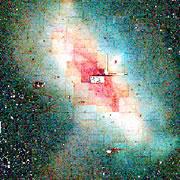 This false-colour mosaic of Andromeda shows the central disk (red) surrounded by a clumpy halo of peripheral stars (yellow).© Scott Chapman, Caltech/ INT2.5m telescope
This false-colour mosaic of Andromeda shows the central disk (red) surrounded by a clumpy halo of peripheral stars (yellow).© Scott Chapman, Caltech/ INT2.5m telescopeAndromeda, the nearest large galaxy, has been found to be almost three times wider than astronomers thought.
Previous estimates had suggested that the spiral galaxy, also known as M31, was about 75,000 light years across. That is slightly smaller than our own galaxy, the Milky Way, which is 100,000 light years wide.
But a project to map the movement of about 3,000 stars in Andromeda's distant outskirts has found that, surprisingly, they too are orbiting the galactic centre in the same plane as the rest of the galactic disk. Because this movement makes them members of Andromeda's stellar posse, astronomers have redrawn its perimeter to include them, boosting the galaxy's diameter to more than 220,000 light years.
“This discovery will be very hard to reconcile with computer simulations of forming galaxies.”
Rodrigo Ibata
Strasbourg Astronomical Observatory, France
This will force theorists to reassess how such galaxies form, says Rodrigo Ibata of the Strasbourg Astronomical Observatory, France, who was part of the research team. "This discovery will be very hard to reconcile with computer simulations of forming galaxies," he says.
Scott Chapman of the California Institute of Technology, Pasadena, presented the results at the American Astronomical Society conference in Minneapolis, Minnesota, on 30 May1.
Stellar leftovers
Within the boundary of a galaxy, matter orbits the galactic centre in an orderly disk. But Andromeda has an extended, clumpy halo of stars that are thought to have been left in the neighbourhood by galaxies that passed by and collided with its outer stars. Astronomers assumed that the force of these collisions would have left these stars buzzing around in random directions, and so didn't count them when measuring the galactic diameter.
To check, researchers used the Keck telescopes in Hawaii to observe these stellar outsiders. Andromeda is the most remote astronomical object normally visible to the naked eye. It lies about 2 million light years from Earth.
ADVERTISEMENT
On one side of Andromeda's disk, light from the stars is redshifted: it is stretched to longer wavelengths as they move away from the Earth. But on the other side, the stars' light is blueshifted to shorter wavelengths as they move towards us. By calculating the difference between the shifts, the astronomers conclude that the outer stars are actually orbiting around the centre of the galaxy, and are therefore part of it.
The clumps of outer stars left from galactic collisions should not, according to current models, get roped into Andromeda's disk. "You just don't get giant rotating disks from the accretion of small galaxy fragments," says Ibata.
Similar observations of other galaxies should be made to work out if this sort of extended disk is unique to Andromeda, says Chapman.
Strasbourg Astronomical Observatory, France
-
References
- Ibata R., et al. ArxivPreprint available at http://arxiv.org/abs/astro-ph/0504164 (2005).
